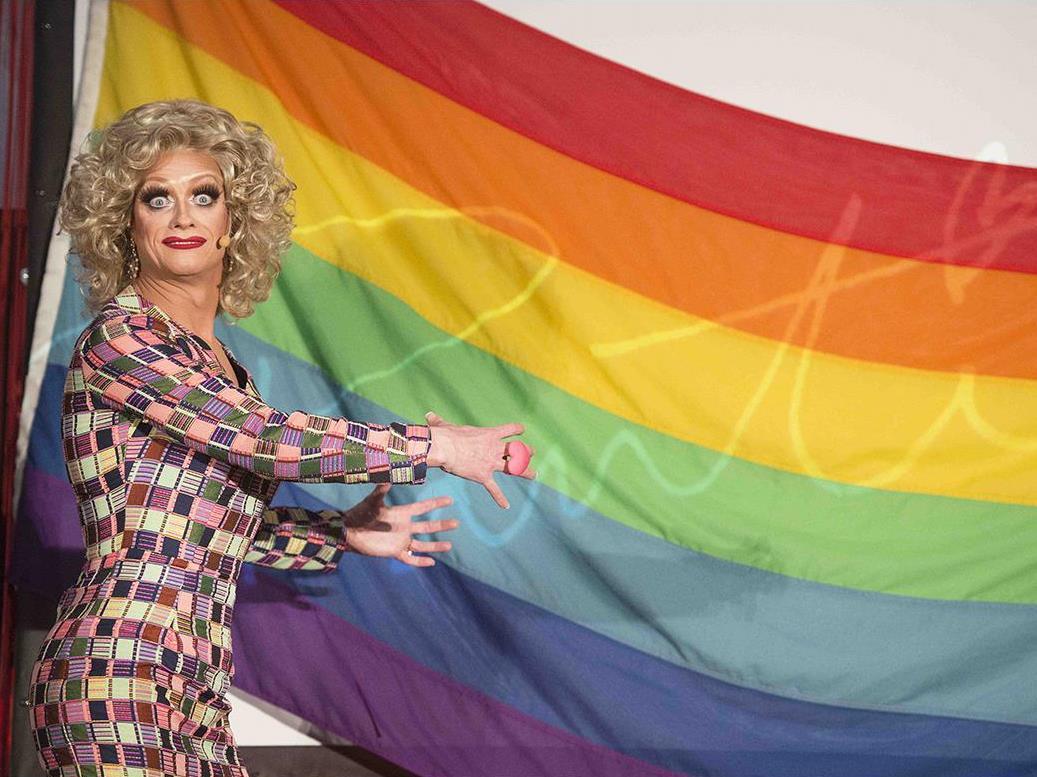Rory O’Neill as Panti Bliss in The Queen of Ireland. Photograph via Transmission Films.
First, she’s spotted addressing a crowd that’s cheering her name. Next, she’s seen sitting in her dressing room prior to a show, telling herself how ‘fucking amazing’ she looks. From the outset of Conor Horgan’s (One Hundred Mornings) documentary, there’s no doubting who his title refers to. With her shimmering golden locks, eye-catching outfits and outspoken, upbeat attitude – and with saying the unsayable as ‘a clown, a fool, a court jester’ her self-described mission –Panti Bliss is The Queen of Ireland.
Panti also repeatedly characterises herself as ‘a giant cartoon woman’; however, as the thoughtful, heartfelt and inspiring film just as quickly makes plain, the packaging that accompanies the drag queen’s persona serves several purposes. Indeed, footage of her speeches and appearances offers a gateway into Rory O’Neill, the man behind the famous performer. More than that, it provides an entry point into the topics his alter ego so passionately and publicly thrusts into the spotlight, particularly Ireland’s marriage equality debate that culminated in the nation’s world-first popular vote in favour of legalisation in May 2015.
The movie that results weaves an inside insight into a drag superstar and an informative overview of a timely subject – aka a blend of entertainment, history and activism – into one engaging, emotive, educative package. Flitting from Panti’s stand-up to Rory’s to-camera chats, and from archival footage of her formative drag years in Japan to his attention-grabbing comments on a television talk show, the combination proves fitting; the tale of the eponymous figure is a complex and compelling tale of rallying against homophobia, living with HIV, challenging stereotypes and trying to agitate for change all at once.
While Panti’s frank, funny countenance is exactly what endears her to audiences, it’s Rory’s candour that drives The Queen of Ireland. The same wit, honesty and sincerity is common to both – it’s the latter’s that energises the former, after all – but Rory’s reflections about growing up, coming out coping with his diagnosis and more truly show the personal struggle that Panti strives to overcome. Glimpsing either at a quiet moment is rare, though, when cinematographer Kate McCullough (Blood Sisters) does, their expressions add another layer to the story. When the film spies Panti in a crowd before collecting her Person of the Year award, or watches Rory sort through his laundry, walk through the streets or banter with his parents in his home town of Ballinrobe, they share something else: a look of resilience and endurance.
Both traits also apply to Horgan, who made his documentary over the course of five years. Indeed, much of its broader content springs from following his point of interest for the right about of time. While the project clearly changed in its focus as a consequence, and while some structural messiness eventuates, so does an intimate yet wide-ranging look at the past and present issues that have troubled Ireland’s LGBTIQ community. Just as Panti has become their spokeswoman, her experiences couldn’t provide a better on-screen guide.
Rating: 3.5 stars out of 5
The Queen of Ireland
Director: Conor Horgan
Ireland, 2015, 82 mins
Release date: September 8
Distributor: Transmission
Rated: PG
Actors:
Director:
Format:
Country:
Release:





